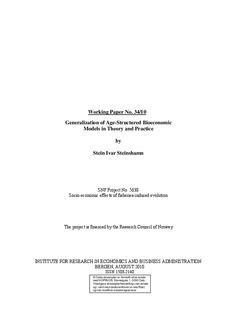| dc.contributor.author | Steinshamn, Stein Ivar | |
| dc.date.accessioned | 2010-11-15T14:59:19Z | |
| dc.date.available | 2010-11-15T14:59:19Z | |
| dc.date.issued | 2010-08 | |
| dc.identifier.issn | 1503-2140 | |
| dc.identifier.uri | http://hdl.handle.net/11250/166300 | |
| dc.description.abstract | The harvesting functions and the stock dynamics in age-structured bioeconomic models are generalized in order to incorporate density dependence. Using this generalization anything from completely uniformly distributed fish to extreme schooling can be analyzed. The classical Beverton-Holt model comes out as a special case of the generalized model.
Both the theoretical outline as well as practical numerical examples are provided, and the generalization can be applied both for simulation as well as optimization purposes given appropriate software.
Non-linear programming is applied to maximize the net present value with the new updating and harvesting functions are used as constraints. One practical result is that pulse fishing seems to become less and less econopmically profitable as we move from uniformly distributed fish to schooling species. The main reason why pulse fishing cease to be optimal in schooling fisheries, is that the economies of scale present in search fisheries gradually disappear when we move from search fisheries to schooling fisheries. This has important implications for how fish stocks ought to be managed in the future. | en |
| dc.language.iso | eng | en |
| dc.publisher | SNF | en |
| dc.relation.ispartofseries | Working paper | en |
| dc.relation.ispartofseries | 2010:34 | en |
| dc.subject | bioeconomic modelling | en |
| dc.subject | age-structured models | en |
| dc.subject | optimal harvesting | en |
| dc.subject | pulse fishing | en |
| dc.title | Generalization of age-structured bioeconomic models in theory and practice | en |
| dc.type | Working paper | en |
